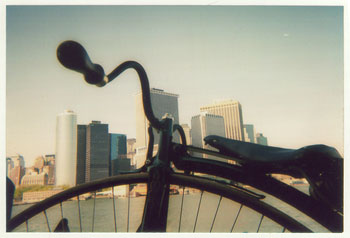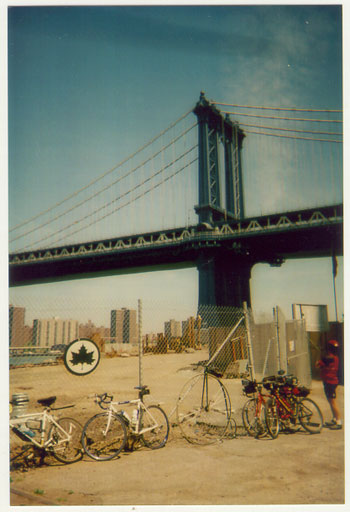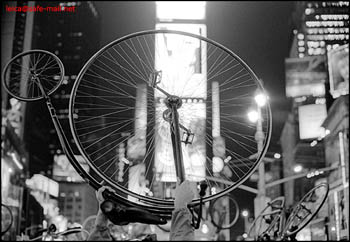[ 63XC.COM | SPATTER | NYC HIGHWHEEL ]
NYC Highwheel
For the last few years, I've been riding a highwheel bicycle in New York City. I've had my picture taken tens of thousands of times as I rode in Five Boro Bike Tours, Critical Mass rides, Greenwich Village Halloween Parades, and other bike events. I've been asked thousands of questions. Here are the ones that I get asked the most, and my answers. What is it called? In the 1870s the first all-metal bikes were built. Solid tires and spoked wheels made for a much better ride (it's always the little things!)As the new metal bikes gained in popularity, riders began to go faster and farther. Manufacturers increased the wheel sizes, enabling riders to go faster with each pedal stroke. Highwheels were born! Throughout the 1880s and 90s the new machines, with their huge front and tiny rear wheels, became massively popular. Their unique and elegant look inspired such terms as Penny Farthing (like the large and small British coins). Around the turn of the century, someone came out with a working chain drive. The new invention had made possible the design of safety bicycles, machines with two equal-sized wheels. Within a few years, they replaced the old highwheels, just as the new steam ships replaced the tall ships on the seas. The brief heyday of the highwheel bicycle drew to a close. How did you get up there? How do you get off? How long did it take you to learn to ride it? At first, riding the highwheel feels very strange because pushing on the pedals steers the wheel, which makes riding no-hands very tricky. Also, the long fork legs and large wheel make for loads of flex. However, as long as you allow plenty of space for turns and keep a little momentum going, it is not that different from riding a regular fix.
Ever crash? Where are the brakes? How do you stop? Where do you get tires? Due to the long spokes and soft metal rim, the highwheeler is a little smoother to ride then you might think. But only a little. Can you wheelie that thing? Where did you get it? Where is it from? How old is it? The original highwheels made in the 1800s were among the most technologically advanced products manufactured. In those days, before mass-production, skilled labor got the highest level of craftsmanship, pushing the limits of technology. That knowledge later transferred to autos and airplanes. Riding the highwheel has really made me appreciate all the advances that make bicycles have gone through in the last hundred years or so. There is a lot to be said for pneumatic tires, freewheels, and brakes that work. So finally... Why? For me, I think it goes back to the early years, riding my first tricycle. The pure joy of hauling ass and cornering without a thought to all the bullshit that seems to creep into bicycling and life in general. This is getting back to my roots as a little dirtbag on wheels, and it still brings the same evil grin to my face, and the same pure enjoyment to my soul. But, while the riding is great fun, I think the best part of the experience is watching the reactions of all the different people in the city. Since NYC is the epicenter of Batman-esque Gotham cool, it takes people a moment to break through the sugar glaze of daily life. After a double take, most of them smile, cheer, or point. Only a few are so far gone that they have no reaction at all. Kids are different--they immediately point and swear like excited miniature longshoremen. It's nice to know that I can bring a moment of joy and amazement into their lives. I'll always remember the young businessman who came up to me one winter evening in Grand Central Station as I waited to go home after a moonlight ride through the frozen paths of Central Park. He was rushing, but immediately stopped when he saw the bike. He said, "I've had a terrible day, could I please see you ride? It would really mean a lot to me." I hopped on the bike and did a circle around the clock in the center of the station. Then I boarded the 1:20am train for home. Another great night of riding in NYC.
Special thanks to all the bike riders in NYC, especially to the folks at Times-Up, Bob Wright, Jeff Westbrook, all the messengers, everyone at Old Skool Track, and everyone who joins in for Critical Mass. [ TOP ] |
Date
v1.0 written November 2003
Photos
Photos © Erik Ferguson except for the B/W Critical Mass shot from Times Square. We can't find who took that one, but we think it's public domain. Sorry if not.
Related
James Allen wrote in 63xc.com #3 about his high wheel life.
If you want to ride yourself, you'll need The Wheelmen.
More on old cycle tech at the Buffalo Bicycle History Museum.
Here's a guy doing a world tour on a highwheel!
For more about riding in NYC, join
Times-Up for Critical Mass or a Central Park ride...
...or get on the Five Boro Bike Tour.
Mailing list
Join the 63xc.com list.


